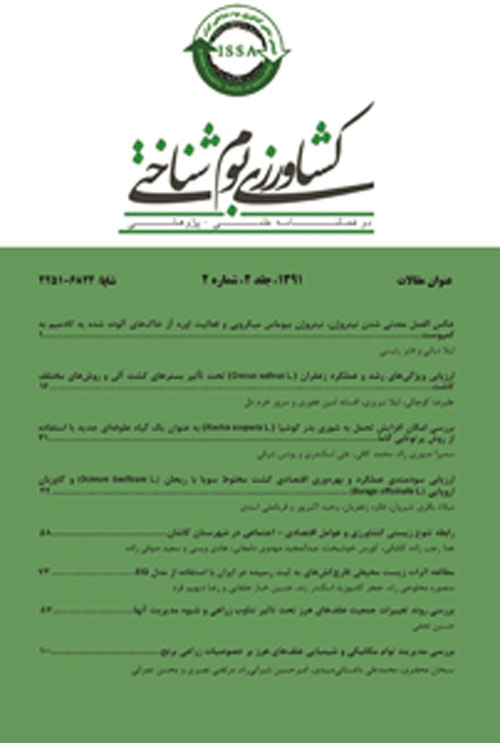Agtoclimatic zoning of barley cultivattion in Lorestan province using analytical hierarchy process (AHP) and fuzzy models
Author(s):
Abstract:
Introduction
Understanding climatic parameters and their effect on crop plants is one of the most important factors for increasing performance and enhancing the product (Yazdanpanah, 2001).This is especially true in rain-fed agriculture where it is extremely important (Farajzadeh, 2007). The very important cereal grain barley is a strategic product that has the largest area under cultivation in Lorestan Province and plays an important role in the agricultural economy of the region. In Iran and worldwide, although many studies have been undertaken on the topic, most studies have been of climatic parameters used annually at various stages of growth and their effects have been studied less. The effect of climatic parameters on phenological stages has been considered, and the aim of this study was to compare the AHP and fuzzy models for zoning barley cultivation in the province and identify susceptible areas where barley is cultivated.Materials And Methods
A study of temperature and precipitation on the phenological stages over a period of 15 years (1995-2009) and at six synoptic stations was applied. The ground parameters of slope, soil, altitude were used. In the preparation phase, the data analysis model applicable to the intended function of this layer was prepared. In this study, the model is the application of an integrated model for locating fertile lands for cultivation of barley using AHP and fuzzy models, The phenological stages of GDD (growing degree days) Obtained (Koanta,1974 . All climatic and phenological barley cultivation was determined according to the written sources and expert opinion and, according to the margin of compatibility and barley cultivation than any of the parameters and criteria, a separate map was prepared for each of the key factors. The standardization and classification was conducted and the layers were standardized about the value of was placed in the AHP formula. And overlay operation was conducted to estimate potential areas and the final map was produced and locations were identified.Results And Discussion
The results showed that rainfall and temperature on the order of the barley has the greatest impact on barley. Overall rainfall and temperature during the flowering, seed germination and tillering stages of barley are the major factors limiting crop growth. Nowhere in the province is barley planted at the right temperature at the tillering stage: The average annual temperature and precipitation are not important but that matter is distributed at the corresponding stages. The results showed that the AHP model of the 55.18 percent overlap region has an optimal condition and is suitable in southern and southwestern parts of the Province, while 44.18 percent of it show medium and inappropriate conditions. In the Fuzzy model, 51.1 percent demonstrated an optimal condition and is suitable for areas that are prone regions in the model, and is drawn towards the center of the province, with 48.9 percent representing medium and poor areas. The AHP model is less flexible than the fuzzy model and serves as the basis of certain criteria. But its advantage is that it does not accept any risk and selected areas in this model certainly enjoy the best conditions for cultivation. This model is suitable for those areas where low-lying land is a disadvantage, because different criteria in this model lead to low flexibility. The bumps better fuzzy approach between the different spectra can be seen in layers, and this case demonstrates that the fuzzy model provides the possibility of deciding which areas are suitable for the needs of barley cultivation and should be chosen. As a result, potentiometric power was found to be more hierarchical than in the fuzzy model and operates more efficiently.Conclusion
Thus, according to the results of the model showed the southern part of the province to be the best place to grow barley, and the fuzzy model showed the potential of finding suitable crops. Keywords:
Language:
Persian
Published:
Journal of Agroecology, Volume:6 Issue: 1, 2016
Page:
11
magiran.com/p1586446
دانلود و مطالعه متن این مقاله با یکی از روشهای زیر امکان پذیر است:
اشتراک شخصی
با عضویت و پرداخت آنلاین حق اشتراک یکساله به مبلغ 1,390,000ريال میتوانید 70 عنوان مطلب دانلود کنید!
اشتراک سازمانی
به کتابخانه دانشگاه یا محل کار خود پیشنهاد کنید تا اشتراک سازمانی این پایگاه را برای دسترسی نامحدود همه کاربران به متن مطالب تهیه نمایند!
توجه!
- حق عضویت دریافتی صرف حمایت از نشریات عضو و نگهداری، تکمیل و توسعه مگیران میشود.
- پرداخت حق اشتراک و دانلود مقالات اجازه بازنشر آن در سایر رسانههای چاپی و دیجیتال را به کاربر نمیدهد.
In order to view content subscription is required
Personal subscription
Subscribe magiran.com for 70 € euros via PayPal and download 70 articles during a year.
Organization subscription
Please contact us to subscribe your university or library for unlimited access!


